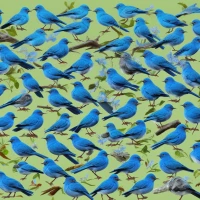Arkansas, known for its diverse ecosystems ranging from the Mississippi Delta to the Ozark Mountains, offers a treasure trove for birdwatching enthusiasts. The state’s landscapes serve as a haven for a vibrant array of avian species, attracting both amateur birdwatchers and ornithologists alike. As the seasons unfold, Arkansas becomes a stage to a mesmerizing spectacle of fluttering wings, each bird with its unique melody and splendid plumage. Let’s embark on a journey to meet the 15 best birds of Arkansas, and uncover the state’s avian wonders. As we delve into the habitats and behaviors of these feathered residents, you’ll discover why birdwatching in Arkansas can be nothing short of magical.
Majestic Raptors: Red-tailed Hawk and Bald Eagle
Red-tailed Hawk: The Soaring Sentinel
The Red-tailed Hawk, a picture of grace, perches dominantly atop the highest trees and poles, surveying its terrain. These raptors are well-adapted to Arkansas’s varied landscapes, from open fields to forests.
- Habitat: Wide-ranging – prefers open areas with high perches
- Features: Broad, rounded wings and a short, wide tail
- Coloring: Rich brown above and pale below, with a streaked belly and a characteristic reddish tail
Spotting a Red-tailed Hawk in flight is a mesmerizing sight as it circles effortlessly on thermal drafts, its keen eyesight tuned for the slightest movement below.
Related article; best birds in guatemala
Bald Eagle: America’s Emblem in the Sky
The majesty of the Bald Eagle is undeniable. As America’s national bird, it inspires awe with its imposing presence and stark, contrasting colors.
Related article; bird with mohawk
- Habitat: Near large bodies of open water with abundant food supplies and old-growth trees
- Features: Large head and beak, heavy body, and powerful wings
- Coloring: White head and tail with dark brown body and wings
In Arkansas, winter is an excellent season to observe these birds, particularly near the Mississippi River and in the Ozark Mountains where they migrate to find abundant fish.
Related article; bird christmas ornaments
Sweet Songsters: Northern Mockingbird and Brown Thrasher
Northern Mockingbird: The Virtuoso Performer
Admired for its musical abilities, the Northern Mockingbird is an unassuming yet talented bird. Often seen perched on high vantage points, it fills the air with intricate melodies.
- Habitat: Open country with sparse vegetation, parks, and residential areas
- Features: Slender build with long legs and tail
- Coloring: Gray upperparts and paler underparts with white wing patches
These birds are prolific singers, capable of mimicking numerous bird songs and sounds, performing ceaselessly during the breeding season.
Brown Thrasher: The Secretive Lyricist
The Brown Thrasher, often hidden among dense shrubbery, is less visible than its mockingbird cousin but equally vocal. Its rich, melodious song is a delight to any who have the fortune to hear it.
- Habitat: Bushy, dense undergrowth and forest edges
- Features: Long tail and slightly curved bill
- Coloring: Bright reddish-brown above with streaked underparts
With a repertoire that includes hundreds of song variations, the Brown Thrasher contributes to the chorus of Arkansas’s woodlands.
Water Lovers: Wood Duck and Great Blue Heron
Wood Duck: The Painted Drake
A vision of elegance, the Wood Duck is a showstopper. Its rainbow-like iridescence and intricate patterns warrant a second look.
- Habitat: Wooded swamps, shallow lakes, and marshes
- Features: Crested head, thin neck, and distinctive eye patterns
- Coloring: Males boast brilliant hues with complex markings, while females are more understated with soft, mottled brown
Early mornings are the best time to catch these ducks as they forage or glide on tranquil waters.
Great Blue Heron: The Stealthy Fisherman
Standing tall, the Great Blue Heron is an iconic sight in Arkansas’s wetlands. With its long legs and s-shaped neck, it is a patient and effective predator.
- Habitat: Freshwater and saltwater environments, often near shores and in wetlands
- Features: Sturdy build with long legs for wading
- Coloring: Blue-gray body with a wide, black stripe over the eye
These herons can be seen stealthily stalking their prey or flying high with slow, deliberate wingbeats.
Colorful Charms: Indigo Bunting and Painted Bunting
Indigo Bunting: The Azure Singer
One cannot help but be drawn to the deep blue of the Indigo Bunting, a true gem especially in the sunlight.
- Habitat: Brushy forest edges, overgrown fields, and roadsides
- Features: Small, stocky build with a short tail
- Coloring: Bright blue in males and brown in females, with a sharper blue in breeding season
Listen for their lively, high-pitched songs from treetops in spring and summer.
Painted Bunting: The Winged Rainbow
The Painted Bunting needs no introduction; its spectacular palette of colors is enough to stop anyone in their tracks.
- Habitat: Dense thickets and woodland clearings
- Features: Short, stout build with a thick bill
- Coloring: Males display an enchanting mix of red, green, blue, and yellow, while females are a more camouflaged green
These birds make Arkansas their breeding grounds, adding vibrancy to the landscape with their presence and song.
Whistlers and Mimics: Eastern Meadowlark and Blue Jay
Eastern Meadowlark: The Golden Whistler
The flute-like whistle of the Eastern Meadowlark carries far across Arkansas’s grasslands, signaling the dawning of spring.
- Habitat: Open fields, pastures, and meadows
- Features: Stocky figure with a short tail and a long, pointed bill
- Coloring: Bright yellow underparts with a black ‘V’ on the chest and streaked brown above
Whether perched on a fence or walking through tall grasses, they add melodious harmony to the countryside.
Blue Jay: The Noisy Mimic
The Blue Jay, a familiar sight and sound, is well-known for its raucous calls and also its ability to mimic other birds’ sounds, including hawks.
- Habitat: Oak and pine woods, gardens, parks, and towns
- Features: Crested head, broad, rounded wings, and a long tail
- Coloring: Bright blue on the wings and tail, with a white face and underparts
They are intelligent and social birds, often seen in family groups especially during their autumnal migrations.
Stately Shorebirds: American Coot and Killdeer
American Coot: The Marshland Trotter
Often mistaken for a duck, the American Coot is a plucky presence in Arkansas’s waterways.
- Habitat: Ponds, lakes, and marshes
- Features: Plump body, chicken-like beak, and unique lobed feet
- Coloring: Slate-gray body with a white bill and forehead shield
With distinctive eating and running-on-water displays, they provide endless entertainment for watchers by the water’s edge.
Killdeer: The Charismatic Plover
The Killdeer might be famous for its broken-wing act, a deceptive ploy to lure predators away from its nest.
- Habitat: Open areas such as fields, lawns, and gravel beds
- Features: Slender and plover-like, with long legs
- Coloring: Brown above and white below with two distinct black bands on the neck
One can often hear their shrill, piercing calls before spotting them on the ground.
Finch Friends: Purple Finch and American Goldfinch
Purple Finch: The Rosy Ruralist
The Purple Finch brings a blush of color to the Arkansas woodlands, particularly during the colder months.
- Habitat: Coniferous and mixed forests, as well as suburban areas
- Features: Chunky build with a short tail and a powerful beak
- Coloring: Males have a raspberry red hue that extends down their back, while females are more subtly colored with bold, brown streaks
Their sweet warbling song is a harmonious complement to the serene winter scenery.
American Goldfinch: The Vibrant Vegetarian
A flash of yellow in the summer sky, the American Goldfinch is Arkansas’s own sunshine.
- Habitat: Weedy fields, floodplains, and gardens
- Features: Small and acrobatic with a conical beak suited for seeds
- Coloring: Males are a bright lemon yellow with a black forehead in breeding season, females and juveniles are more subdued
Goldfinches are a joy to watch, especially as they flit about in their undulating flight pattern, calling sweetly to one another.
Backyard Beauties: Carolina Chickadee and Northern Cardinal
Carolina Chickadee: The Tiny Charmer
Don’t let the size of the Carolina Chickadee fool you; these birds are full of character and presence.
- Habitat: Deciduous and mixed woods, willow thickets, and suburban backyards
- Features: Small size with a large head, short neck, and full, rounded body
- Coloring: Black cap and bib with soft gray back and flanks and white underparts
Their high-pitched call and song are the background music of many Arkansan landscapes.
Northern Cardinal: The Iconic Red Bird
The Northern Cardinal is a favorite among birdwatchers, with its striking red plumage and melodic whistle.
- Habitat: Woodlands, thickets, suburban gardens, and swamps
- Features: Prominent crest, strong bill for seeds, and long tail
- Coloring: Vibrant red in males and a dusky tan with hints of red in females
Cardinals are year-round residents of Arkansas, providing dashes of color even on the grayest winter days. Moreover, as the species lacks a true song migration pattern, they remain a consistent highlight of the state’s birding scene.
As we reach the conclusion of our ornithological exploration through Arkansas, it’s clear that the state’s skies are streaked with the wings of countless avian wonders. From the majestic flight of the Red-tailed Hawk to the tiny, but bold, Carolina Chickadee, each bird adds a unique brushstroke to Arkansas’s natural canvas. Whether you’re a seasoned birder or simply someone who appreciates the gentle trill of a songbird, the birds of Arkansas are sure to captivate and inspire.
Remember, the key to truly appreciating these avian marvels is to venture out into the habitats they call home. Keep your binoculars at the ready and your field guides in hand as you embark on your birdwatching journey. Every flutter and chirp is part of the symphony of Arkansas’s natural beauty – a symphony that’s waiting for you to sit back, listen, and observe.










